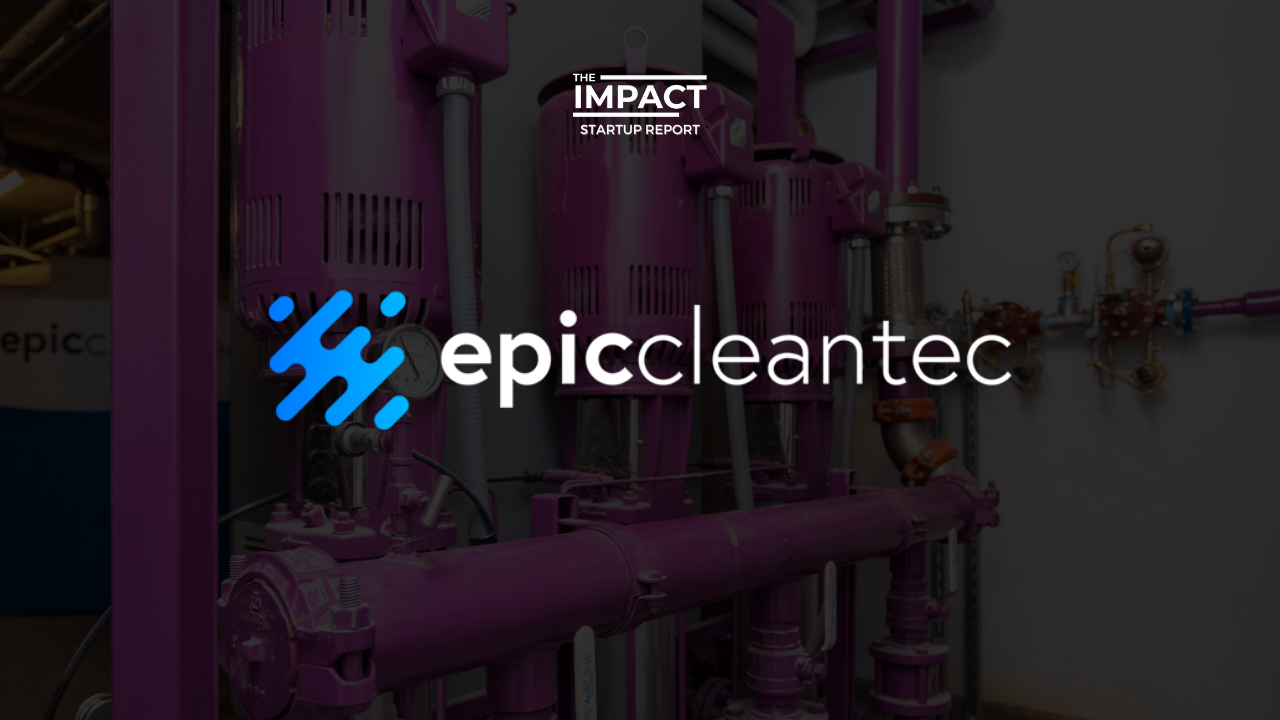70 percent of the world’s population is predicted to be living in urban areas by 2050. This means we need to rethink how our cities are designed as the status quo simply won’t keep up. The rate at which society is adding new building stock to the global supply is the equivalent of adding a new Manhattan every month for the next three decades.
Epic Cleantec is helping to rethink how to manage water resources by pioneering new reuse technologies and attempting to transform the conversation through work with business leaders, regulators, and policymakers. The combination of aging infrastructure, growing populations, and an increasingly unpredictable climate make sustainable urban water and wastewater management a defining global challenge of the 21st century.
In the US, we rely on water and wastewater infrastructure built 30 to 100 years ago, much of which needs maintenance or replacement. Since the late 1800s, the usual approach to designing these systems—centralized networks of subterranean pipes connecting to a single treatment plant–has remained unchanged. Water and sewer rates are rising 5–10% annually in metro areas across the country to support necessary repairs and upgrades.
Enter Epic Cleantec
Epic Cleantec’s fully customizable systems process wastewater onsite, creating treated (non-potable) water, captured heat, and high-quality soil amendments that can be used at the building. They offer real estate developers and building owners simple, turnkey solutions that significantly reduce utility costs and increase resilience and sustainability.
The conventional approach to wastewater consists of a building connecting to the municipal sewer network and sending all used water from toilets, showers, sinks, laundry, etc. directly into the city’s municipal collection network.
Instead, they are placing an Epic system in the basement of the building and treating that water right onsite. By capturing and processing a building’s wastewater—either black or gray—the system produces three outputs:
- recycled water for non-potable applications, such as toilet flushing, cooling tower makeup, irrigation, and laundry
- recovered waste heat energy
- repurposed organic solids for use as a natural, carbon-rich soil amendment
The Epic approach can help a building reuse up to 95% of its water, saving building owners hundreds of thousands of dollars annually on their water and sewer bills while assisting the cities in reaching their lofty water reuse goals more quickly.
How it works
Epic’s technology platform is optimized for resource recovery. Their systems can capture and processes the entirety of a building’s wastewater—both black and gray.
In doing so, Epic’s approach produces three outputs:
- highly purified recycled water
- recovered wastewater heat energy
- natural carbon-rich soil amendments
As a first step in the treatment process, untreated water is fed through a microscreen to collect wastewater solids which are held in a specially designed bin for off-site solids handling. Once the water has passed through the microscreen, it is treated via advanced technologies to produce a highly purified water effluent.
They employ several proven wastewater treatment technologies in their approach, including membrane bioreactor (MBR) technology, which is a combination of biological and physical filtration. The MBR process produces highly purified water that is further treated via disinfection and purification steps like UV, chlorination, and even reverse osmosis as necessary. In addition to water reuse, their systems can extract wastewater heat and convert wastewater solids into high-quality soil amendments.
Furthermore, their systems can recover up to 25 kW per 1,000 gallons treated and utilize this energy for other processes in the building, such as preheating domestic hot water. Wastewater solids are used to produce soil that can be integrated into the local landscape program, providing plants a locally sourced, carbon-rich soil amendment. These features can reduce energy consumption and help offset the carbon footprint of a reuse system.
Their primary customers, real estate developers and owners, are seeing escalating pre-development costs and monthly water and sewer rates. The Epic system may reduce water consumption by up to 95%, saving owners hundreds of thousands of dollars yearly.
The market
Advanced wastewater treatment and reuse have been around for decades, but it has been focused almost exclusively on the centralized, municipal scale. The next decade of water and wastewater will be defined by aging infrastructure, rising operational costs, stringent regulatory requirements, insufficient capital sources, and the accelerated adoption of new technologies and approaches.
As large-scale water and wastewater capital projects remain underfunded, Epic sees an opportunity to supplement the broader industry with a more distributed model, beginning in our cities. Rather than a sole focus on the rehabilitation and expansion of expensive centralized networks, a more distributed model will help save utilities money on their necessary capital expenditures and ongoing operational costs.
In many respects, distributed water reuse is where rooftop solar was 10-15 years ago.
For example, they have one use case planned for a 55-story mixed-use building in San Francisco. By implementing Epic’s onsite water reuse system, the project will save an estimated 48% on annual water/sewer bills in addition to $300,000 in savings on one-time water and sewer connection fees. This equates to over $12M in savings over 10 years, with the potential to reuse over 24,500,000 gallons of water annually. That’s enough to fill 41 Olympic swimming pools.
Their primary customers, real estate developers and owners, are seeing escalating pre-development costs and monthly water and sewer rates. The Epic system may reduce water consumption by up to 95%, saving owners hundreds of thousands of dollars yearly.
The impact
The climate impact of having an Epic system installed at a commercial building includes:
- Saving water, diversifying municipal water supply portfolios
- Reducing water and sewer bills – saving owners hundreds of thousands of dollars annually
- Reducing project’s overall carbon footprint when heat recovery is leveraged
- Diverting organics from landfills, lowering greenhouse gas emissions
- Producing natural soil amendments, increasing carbon sequestration efforts
- Alleviating the strain on aging utility infrastructure and operations, reducing combined sewer overflows and municipal costs
- Setting standards for modern, sustainable development, strengthening resilience in a changing climate
The broader industry trends
The need for large-scale adoption of decentralized water recycling solutions is more significant than ever due to climate change and water scarcity issues, aging infrastructure, and urban population growth.
According to The Working Group II 2022 IPCC Sixth Assessment Report, even under a scenario where urban water gets the highest priority, more than 440.5 million people in cities globally are projected to face a water deficit by 2050. More cities and states are beginning to adopt regulatory requirements that mandate onsite water reuse to help address these issues – San Francisco, Los Angeles, and Austin are just a few of the major U.S. cities now requiring or incentivizing onsite water reuse for new development projects.
As such, there are many exciting trends to be watching in the water sector.
While this list is certainly not exhaustive, here are a few of the significant trends to be watching:
- the expansion of distributed water and wastewater infrastructure;
- accelerated adoption of water reuse as part of the shift towards a more circular economy;
- the digital transformation of the sector with the implementation of IoT and AI technologies;
- focus on the treatment of contaminants of emerging concern including PFAS.
Policy movements
In 2014, Los Angeles mandated that cooling towers in all new buildings over 25 stories must use at least 50 percent reused, nonpotable water, including treated blackwater. In 2015, San Francisco made onsite water reuse systems mandatory for all new construction of more than 250,000 square feet of gross floor area, and on January 1, 2022, that requirement was lowered to 100,000 square feet.
The California State Legislature has ordered the State Water Board to create water reuse standards to support cities in creating local water reuse programs, notably planning to update Title-22 standards with SB 966.
Outside of California, in 2020, Austin, Texas instituted a program stipulating that onsite water reuse systems which replace 1,000,000 gallons or more of potable water per year are eligible for program funding up to $250,000; systems that replace 3,000,000 gallons or more of potable water per year are eligible for program funding up to $500,000. As more cities and states grapple with the long-term challenges of how they will provide reliable water and sewer service to their homes and business, we see distributed water and wastewater infrastructure continuing to be a key strategy in urban sustainability and resilience.
Outlook
Epic Cleantec’s team has a collective experience that spans water and wastewater engineering, building design, project finance, public policy and operations. This multidisciplinary approach has allowed them to create a one-stop-shop approach, simplifying their clients’ entire water reuse process. Given the massive policy push and incentives coming from the government to improve wastewater management infrastructure, it is easy to see why onsite water reuse will be employed in cities throughout the world.
It is plausible that these systems by Epic will ultimately become as common as any other large mechanical or plumbing system.
About The Author

Swarnav has over 10 years of experience in the energy & climate tech space, holds 2 patents and is active in the tech, climate and media industries. He specializes in Product/Product Innovation as well as Go-To-Market and Growth Strategy.
By training he’s a Materials Engineer with a background in research from his time at Georgia Tech and University of Illinois (UIUC).
He founded TouchLight a utility backed energy company focused on developing IP for utilities and startups pushing electrification forward. He also serves as the appointed Chairman for the Town of Yorktown’s Climate Smart Communities Task Force, where he helps with drafting legislation and enabling sustainability efforts within the town.
Concurrently, Swarnav founded The Impact to help investors, emerging founders and driven climate enthusiasts discover and identify new climate-tech startups, technologies and opportunities before they hit the traditional media sources.

